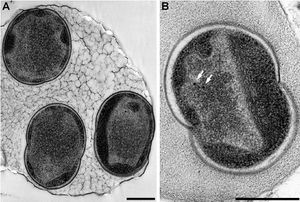Conexibacter
Classification
Domain: Bacteria
Phylum: Actinobaceria
Class: Actinobaceria
Sub-Class: Rubrobacteridae
Order: Solirubrobacteriales
Family: Conexibacteraceae
Genus: Conexibacter
Species
Conexibacter woesei (DSM 14684) (type strain), Conexibacter arvalis (DSM 23288)
|
NCBI [1] |
Description
Bacteria of the genus Conexibacter are characterized as small rods with width of 0.6-0.7 µm and length of 0.9-1.2 µm. They are Gram-positive, aerobic, non-sporulating and are motile by characteristic long peritrichous flagella. The type strain of this genus is Conexibacter woesei named in honor of Carl R. Woese, a pioneer with his work on the use of 16S rRNA for phylogenetic analysis. C. woesei was isolated from forest soil in Gerenzano, Italy and grows optimally at pH 7-7.5 and at 28-37ºC.
The genus Conexibacter was first developed in 2003 with the discovery of the type strain C. woesei. In 2012 a second species, Conexibacter arvalis, was isolated from Japan field soil. Both isolates are available in pure culture. The genus is known as a very deep branch of the phylum Actinobacteria having only a 90% similarity to their next closest genus Thermoleiphilum, and being only 83.8% similar to the well known genus Rubrobacter, which contains species known to be the only thermophiles that are radiation resistant. Since it is such a deep reaching branch of Actinobacteria there is not much diversity in the lineage of Conexibacter. This lack of diversity is further amplified by the presence of only two known species. C. wosesi and C. arvalis do represent some diversity between them. Specifically C. woesei was found to be oxidase positive while C. arvalis is oxidase negative, suggesting that it may have an alternative electron acceptor to C.woesei or that it may have a different cytochrome to transfer terminal electrons to oxygen. C. arvalis has a higher G+C content than C. woesi with 74-5% compared to 71% and it is slightly more halotolarant.
The genus Conexibacter is not primarily studied. Other than the discovery of two isolates, these species are only reported when they are discovered in metagenomic studies. However, though not much is known about this genus there are characteristics of this that make it very intriguing. Once such example is their chemotaxonomy. Both C. wosesi and C. arvalis have the tetrahydrogenated menaquinone MK-7(H4) as the major component of their plasma membrane, a trait that has not yet been reported in bacteria.
Ecology and Significance
Genome Structure
|
NCBI GenBank: [2] |
C. woesei complete genome.
Metabolism
References
[1] Monciardini, Paolo, et al. "Conexibacter woesei gen. nov., sp. nov., a novel representative of a deep evolutionary line of descent withing the class Actinobacteria." 53 (2003): 569-576. Print.
Figures
[1F]
[3] [2F] [4] [3F] [5] [4F] [6] [5F] [Original Figure. Author: Pawan Dhaliwal] [6F]
http://microbewiki.kenyon.edu/index.php/File:Lorenzo.gif
[7F] [7]
Author
Page authored by Andrew Steinberger, student of Prof. Katherine Mcmahon at University of Wisconsin - Madison.

